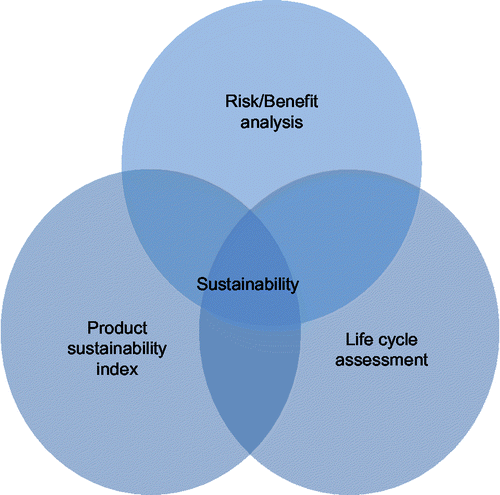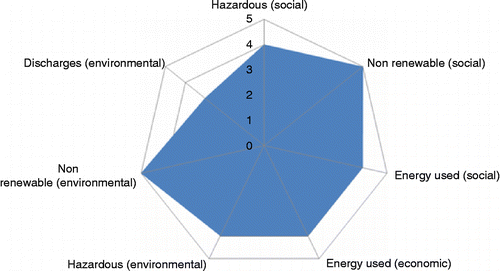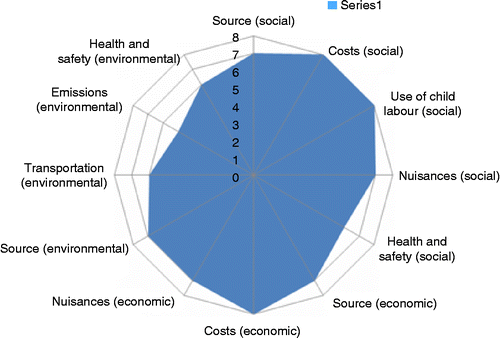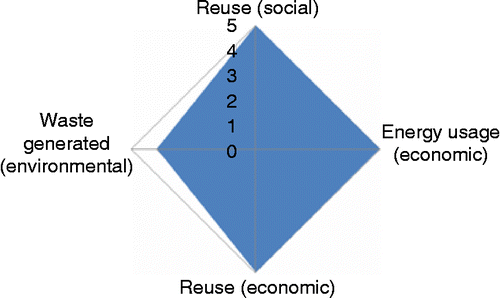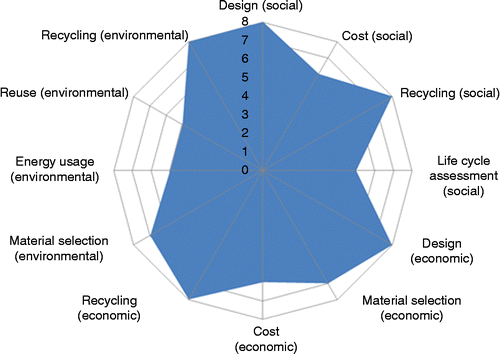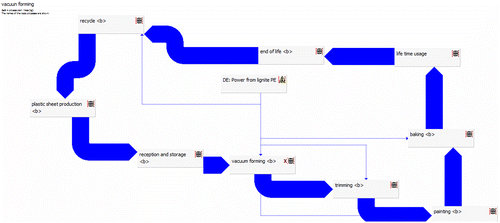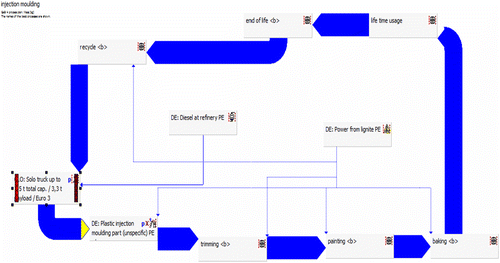Abstract
The present world is facing problems like rapid depletion of natural resources and undesired environmental changes on a global scale. Manufacturing organisations are realising the importance of mitigating the present crisis and are adopting sustainable manufacturing principles. Since it is important to achieve sustainable manufacturing, sustainability assessment models were developed. Sustainability assessment models have their own drawbacks and may not provide clear scope for complete sustainable development. A system approach has been developed to overcome this shortcoming by integrating various sustainability assessment models that are already in practice. This article reports the advantages of collecting the advantages of individual sustainability assessment models and how the implementation of the integrated approach has helped to identify the current sustainability level and the scope for future developments in an automotive industry.
Notations
| PSIen | = |
Product sustainability index of environmental aspect |
| PSIsoc | = |
Product sustainability index of social aspect |
| PSIeco | = |
Product sustainability index of economic aspect |
| PSIpm | = |
Product sustainability index at pre-manufacturing phase |
| PSIman | = |
Product sustainability index at manufacturing phase |
| PSIuse | = |
Product sustainability index at usage phase |
| PSIpu | = |
Product sustainability index at post-use phase |
1. Introduction
The current world is witnessing some serious environmental and economic crises. Non-renewable resources such as fossil fuels and minerals are rapidly depleting. Environmental crises like global warming and ozone layer depletion also are of great concerns (Sakao Citation2009). Major contribution for the current crisis comes from manufacturing industries. Realising this, manufacturing organisations are bringing changes in manufacturing paradigm (Rao Citation2008). Sustainable manufacturing and sustainable development have come into prominence. The manufacturing sector, which lies at the core of industrial economies, must be made sustainable in order to preserve the high standard of living achieved by industrialised societies and to enable developing societies to achieve the same standard of living sustainably (Jayal et al. Citation2010). Sustainable organisations reduce production cost and prevent environmental problems to maintain the atmosphere clean and green (Gungor and Gupta Citation1999). However, existing practices of product development in manufacturing companies still focuses on cost, function and quality (Kaebernick et al. Citation2003). Sustainability in general deals with reduction of consumption of resources including material, energy and water resources and reducing emission of hazardous and non-hazardous wastes into environment. In order to develop and maintain the sustainability of the organisation, sustainability assessment tools are required. A number of sustainability assessment models are already proposed. The available tools do not adequately assist industry decision makers to assess and evaluate their operations in terms of internal and external impacts. Optimal decisions can only be made when the economic, social and environmental consequences are taken into consideration (Labuschagne et al. Citation2005). Since sustainability of the organisation has its roots in almost all activities of the organisation, a single sustainability assessment model may not be a sufficient solution for sustainable development (Jayal et al. Citation2010). There is a need for an efficient sustainability assessment tool that can perform the function from more than one perspective. This article is concerned about developing a holistic approach for assessing the comprehensive sustainability of an organisation from more than one perspective. This article also reports the usefulness of combining the already existing models for the ease of managerial decision making. The proposed models have been implemented in a manufacturing organisation. The implementation of this model enabled the decision makers of the case organisation to get a workable picture of sustainability of the organisation.
2. Literature review
The literature review has been reviewed from the perspective of sustainability. Jayal et al. (Citation2010) have mentioned that achieving sustainability in manufacturing requires a holistic view spanning not just the product and the manufacturing processes involved in its fabrication, but also the entire supply chain. Ijomah et al. (Citation2007) have cited that developing sustainable approaches for manufacturing is a critical global concern. This challenge has to be met by carrying out eco-design by improving remanufacturing efficiency and effectiveness. However, environmental and competitive pressures are changing the global and business environment and this is fuelling interest in facing the above challenges. Jovane et al. (Citation2008) have presented the necessary steps for progressing from economic growth to sustainable development. A model named as reference model for proactive action (RMfPA) is proposed to develop and implement competitive sustainable manufacturing at national and global levels. The overall results have indicated that RMfPA is a good model for pursuing competitive sustainable manufacturing. Azzone and Noci (Citation1996) proposed a new methodology for assessing environmental impacts of new decision products. The author defines an operating framework for the identification of significant evaluation criteria to support decision making. It thus makes an integrated approach taking consideration of tangible and intangible effects. Bert (Citation1997) provided a number of options and issues which companies and organisations seeking to incorporate environmental issues in product design and realisation should consider. The author has discussed about approaches for reducing the environmental impact. Gerald et al. (1999) developed environmentally sound processes in the chemical industry. The environmental impacts were quantified by the EcoIndicator 95 method. It was updated to EcoIndicator 99 which offers a way to measure various environmental impacts and shows the final result in a single score. The method is now succeeded by the new ReCiPe which deals with the environmental impact on sustainability considering a wide range of factors. The author has explained the work-up procedures causing more environmental impact than the technology itself. Gungor and Gupta (Citation1999) have presented environmentally conscious manufacturing and product recovery (ECMPRO). ECMPRO involves integrating environmental thinking into new product development including design, material selection, manufacturing processes and delivery of the product to customers, in addition to the end-of-life management of the product after its useful life. Park and Seo (Citation2003) have presented a new appropriate life cycle assessment (LCA) methodology for the product concept by grouping products according to their environmental characteristics. Kaebernick et al. (Citation2003) have presented the integration of environmental requirements throughout the entire lifetime of a product. They presented the concept of an approach to product development, based on a paradigm for sustainable manufacturing. Hansjoerg et al. (Citation2005) has mentioned that promoting eco-design helps in understanding the sustainability concept. The author has contributed an idea about how to carry out the eco-design in the case of a particular product. Bovea and Powell (2006) has evaluated the environmental behaviour of materials in such a way that it can be incorporated directly into a multi-criteria decision problem, along with the other design considerations. The study demonstrated the need to perform a sensitivity analysis when a single environmental score is applied during the process of selecting materials in order to enhance the environmental performance of products. Kalnes et al. (2003) proposed that environmentally conscious design of processes and products is increasingly viewed as an integral strategy in the sustainable development of new refining and chemical processes. They developed a neural network to predict an appropriate LCA of grouping products in conceptual design. Rehan and Faisal (Citation2006) proposed methodology GreenPro-I which is a systematic approach to estimate environmental risks and impacts associated with the life cycle of products, processes and services. The author assessed the extraction, excavation and processing of raw materials; manufacturing, transportation and distribution; use, recycle and final disposal. Rao (2008) discussed about the evaluation of environmentally conscious manufacturing programmes using multiple attribute decision-making methods. Rusinko (Citation2007) studied the relationship between specific environmentally sustainable manufacturing practices and specific competitive outcomes in an environmentally important but under-researched industry. Sakao (Citation2009) considers the application of quality engineering in the early phase of environmentally conscious design. The author has classified the environmental characteristics of products and services. Social life cycle assessment (S-LCA) guidelines (http://www.unep.fr/shared/publications/pdf/DTIx1164xPA-guidelines_sLCA.pdf) mention about the social aspect of the LCA. S-LCA guidelines deal with the ISO 14040 and 14044 standards for LCA. Adaptations for the consideration of social and socio-economic issues are described in the framework mentioned. Social and socio-economic LCA guidelines complement environmental LCA and life cycle costing, contributing to the full assessment of goods and services within the context of sustainable development. Ortiz et al. (Citation2009) performed a work on sustainability in construction industry which dealt with recent developments in LCA. Finkbeiner et al. (Citation2010) have proposed that for the environmental dimension well-established tools like LCA are available. For the economic and social dimension, there is still need for consistent and robust indicators and methods. Halleux et al. (Citation2006) have used centrum Milieukunde Leiden (CML) method to perform LCA. They explored the environmental impact of wastewater treatment plant by life cycle analysis using CML approach.
3. Proposed model
Sustainability aspects can be incorporated at product and process levels. At the process level, there is a need to achieve optimised technological improvements and process planning for reduced energy and resource consumptions, toxic wastes, occupational hazards, etc. At the product level, sustainability can be achieved by reducing the energy of the product and recovering the waste generated (Gerald et al. Citation1999). Various models for evaluating sustainability are in use. Certain models deal with identifying the sustainability status at product level (Jayal et al. Citation2010), and certain models deal with identifying the sustainability status at process level (Crouch and Wilson Citation1982). An attempt to assess the product sustainability using an integrated model which constitutes the following models is attempted:
| 1. | product sustainability index (PSI) by weighted sum method, | ||||
| 2. | risk/benefit worksheet and | ||||
| 3. | LCA. | ||||
Figure shows the approach of the integrated model. Here, each of the above approach has been carried out from different perspectives of sustainability individually. In the PSI, calculation data were collected from decision makers of the case organisation and give a picture of product sustainability. LCA deals with the technical aspect of the product which includes cost and environmental impacts, which deal with process sustainability. Risk/benefit worksheet gives a visualisation of the current sustainability status and future scope of development and helps in taking immediate improvement actions (Crouch and Wilson Citation1982). These three models have individual advantages which are integrated. This case study was performed by integrating the above-mentioned models since the goal of this integrated approach matched with the status of our case organisation.
3.1 PSI by weighted sum method
Jayal et al. (2010) presented a simplified and generalised procedure for computing PSI by calculating the weighted sum of different sub-elements within the three main sustainability element categories – environmental, social and economic impacts – for each of the four life cycle stages: pre-manufacturing and manufacturing, use and post-use. PSI is calculated by summing the scores of all influencing factors in each matrix category to calculate the percentage value. For example, PSI for the environment component for pre-manufacturing stage can be calculated as follows (Jayal et al. 2010):
3.2 Risk/benefit worksheet
The sustainable development guidance includes three basic concepts – evaluate environmental, social and economic impacts at the same time; any evaluation must be ‘holistic’ by considering each element of the life cycle from raw materials, manufacture, distribution, use and final disposal and finally the views of the interested parties or stake holders must be taken into consideration. Crouch and Wilson (Citation1982) have already used this method to assess the risk associated with nuclear power plants, saccharin use and mass chest radiography. In this model, a work sheet is developed which contains a list of topics with the ability to be added at any time. Each topic must be given a score on a scale of 0–10, defined if the impact is related to social, economic or environmental or combination of any of these. The impact is given as high, medium or low for each of the topics and finally indicating if it is a risk or benefit. The basic objective is to identify and prioritise the key risks and benefits from the issues and concerns assessed. In the case organisation, the risk/benefit analysis is performed at two stages – raw material acquisition stage and other at the manufacturing stage. At each stage, the risk/benefit worksheet is listed and the corresponding risk and benefits are identified based on the discussions held with the customers.
3.3 Life cycle assessment
LCA considers the entire life cycle of the product: extracting and processing raw materials; manufacturing, transportation and distribution; use, reuse and maintenance; recycling and final disposal (Environmental management – ISO Citation14000 family of International Standards). By definition, LCA only considers environmental issues. In reality, there are also other issues, e.g. social, economic, political and technical, which cannot be ignored in any decision. Therefore, LCA must be seen in a broader context, as a tool that provides information on the product's environmental impacts for decision making. Currently, LCA considers air, water and soil emissions together with mass and energy requirements (Environmental management – ISO Citation14000 family of International Standards). The evaluation of the environmental impacts of those has been included, even though the methodology for impact assessment is still developing. LCAs are being widely used by a variety of users for a range of purposes.
According to the ISO standards on LCA, it can assist in the following aspects:
| 1. | Identifying opportunities to improve the environmental aspects of products at various points in their life cycle. | ||||
| 2. | Decision making in industry, governmental or non-governmental organisations (e.g. strategic planning, priority setting, product and process design or redesign). | ||||
| 3. | Selection of relevant indicators of environmental performance, including measurement techniques. | ||||
| 4. | Marketing (e.g. an environmental claim, eco-labelling scheme or environmental product declarations). | ||||
LCA is conducted according to ISO 14040 and 14044 standards (Environmental management – ISO Citation14000 family of International Standards). LCA consists of four steps which are described in the following sections.
3.3.1 Goal and scope definition
According to the ISO 14040 standard, the first phase of an LCA is the definition of the goal and scope (Environmental management – ISO Citation14000 family of International Standards). In this step, all general decisions for setting up the LCA system are made. The goal and scope should be defined clearly and consistently with the intended application. An LCA is an iterative process and this allows redefining the goal and scope later in the study based on the interpretation of the results.
3.3.2 Life cycle inventory
The inventory analysis is the LCA phase that involves the compilation and quantification of inputs and outputs for a given product system throughout its life cycle or for single processes (Environmental management – ISO Citation14000 family of International Standards). The inventory analysis includes data collection and the compilation of the data in a life cycle inventory (LCI) table.
As data are collected and more is learned about the system, data requirements or limitations may be redefined or a change in the data collection procedures in order to meet the goal of the study may be required. Sometimes issues may be identified which require revisions of the goal or scope definition of the study. After all process data are collected, an LCI table for the whole product system is created. The LCI is often presented as a table listing all of the material and energy inputs and outputs for the system.
The data for each unit process can be classified as follows: energy inputs, raw material inputs, ancillary inputs, other physical inputs, products, co-products, wastes and other environmental aspects.
3.3.3 Life cycle impact assessment
The life cycle impact assessment (LCIA) identifies and evaluates the amount and significance of the potential environmental impacts arising from the LCI. The inputs and outputs are first assigned to impact categories and their potential impacts are quantified according to characterisation factors.
The LCIA involves several steps according to the ISO standard. These can be found in more detail in the ISO 14044 standard (Environmental management – ISO Citation14000 family of International Standards). Within the scope of a study, certain elements are defined for the LCIA. Mandatory elements include the selection of relevant impact categories, classification and characterisation. The optional elements of the study are normalisation, grouping and weighting. There are different methods that can be used to perform LCIA. These methods are continuously researched and developed by different scientific groups based on different methodologies.
In LCIA methods, such as tool for the reduction and assessment of chemical and other environmental impacts or CML, two main approaches are used to classify and characterise environmental impacts: the problem-oriented approach (mid-point) and the damage-oriented approach (end point). The so-called CML method is the methodology of the CML of the University of Leiden and focuses on a series of environmental impact categories expressed in terms of emissions to the environment. The CML method includes classification, characterisation and normalisation. Further information is available at the CML, University of Leiden. LCA is a large process conducted to study the sustainability of an industry. Software packages are available to reduce the complexity of the process, but still it warrants collection of huge amounts of data which may be at times practically impossible. An attempt was made to study the sustainability of a process by LCA software GaBi. An alternative process used to manufacture the same product was considered, environmental performance of both the processes was studied and the results were compared. Two or many life cycles were modelled for the same product. The whole product life cycle was considered to be same in all cycles except for the manufacturing process. Since the same product cycle was evaluated with many different processes and for the reason that the assessment was made to compare the sustainability of the process alone, correctness and consistency of the data associated with the process alone were given importance while other data that were fed were based on reasonable assumptions. The assumptions were made on small details required for modelling the processes such as trimming, painting, baking, life cycle phase and end-of-life phase on GaBi (Figures and ), which are practically impossible to collect.
Here, LCA is used mainly for selecting the sustainable process by comparing candidate alternative processes, and few general conclusions were also drawn for product sustainability.
The credibility and validity of the results arrived through the study with GaBi software were assessed on discussion with the decision makers of the case organisation and were found to be acceptable.
4. Case study
The study was conducted in a case organisation – Maini Plastics and Composites. The organisation is located in Bangalore, India. It manufactures instrument panel of the car using acrylonitrile butadiene styrene (ABS) sheet. The proposed integrated model has been applied to the case organisation to assess the sustainability level. The results have been analysed and discussed with the decision makers of the case organisation.
4.1 Evaluation of product sustainability using weighted sum method
The functions and operations of the case organisation were thoroughly analysed and influencing factors were evaluated. These evaluated factors were filled in the sustainability table and the overall PSI was calculated. Table shows the evaluation of PSI.
Table 1 Product sustainability index.
PSIen is calculated as an average of 7, 7 and 6, which are the scores of the corresponding column. Therefore, PSIen is given by
Similarly by computing sustainability index at the various levels, the overall PSI is found to be 68.73.
4.2 Risk/benefit sheet
Since acquiring raw materials and manufacturing are two main operations involved in the case organisation, the risk/benefit sheet is developed for those two operations. Risk/benefit worksheet is developed based on the inputs given by the customers.
Table shows the risk/benefit worksheet for the raw material acquisition phase. The corresponding risk/benefit is identified. The risk/benefit is classified either as low (L), medium (M) or high (H). Table shows the risk/benefit worksheet for manufacturing phase.
Table 2 Risk/benefit worksheet for raw material phase.
Table 3 Risk/benefit worksheet for manufacturing phase.
Figure shows the risk categorisation for the raw material phase.
From this categorisation, we can conclude that the major risk is from the source of non-renewable energy which is used for manufacturing.
Figure presents the benefit categorisation for raw material acquisition phase.
From this categorisation, we can conclude that the major benefit is from the recyclability of plastics which are being used.
Figure presents the risk categorisation for manufacturing phase.
From this, we can conclude that the major risk is in the form of energy usage. Use of high energy emerges as a major risk in manufacturing phase.
Figure presents the benefit categorisation for manufacturing phase.
Design of the product is the major benefit according to the benefit categorisation.
Radar charts were plotted based on the risks and benefits as shown. This clearly depicts the risks and benefits and their quantity pictorially.
4.3 Life cycle assessment
The case organisation manufactures instrument panel through vacuum forming process. An alternative process for this product was found to be injection moulding. Hence comparison between these two processes is made through LCA.
The modelled life cycle of the vacuum forming process is shown in Figure . The entire life cycle is included starting from manufacturing till it is recycled.
The modelled life cycle of the injection moulding process is shown in Figure .
Inventory analysis was performed with the software. Those results are tabulated.
Table shows the comparison of inventory analysis between vacuum forming process and injection moulding process. The unit is taken as kg equivalent.
Table 4 Inventory analysis.
Table discusses the impact analysis of both the processes. This deals with the emissions to various environments such as air and seawater.
Table 5 Impact analysis.
Table categorises the various emissions to air. It includes organic and inorganic emissions to air. All those contributions to air are considered.
Table 6 Various emissions to air.
Table categorises the human toxicity potential (HTP). It shows the various emissions caused which are responsible for human toxicity.
Table 7 Human toxicity potential.
5. Inferences
After the integrated approach for sustainability evaluation was applied to the case organisation, the results from the study have been discussed with the decision makers of the case organisation and several inferences were drawn. The inferences through each approach are listed below.
5.1 Life cycle assessment
| a. | When compared with the alternative process of vacuum forming, that is, injection moulding, we are able to conclude the following:
| ||||||||||||||||||||||
| b. | The overall sustainability of the vacuum forming process is higher than the injection moulding process. But still there is a scope of improvement of sustainability by
| ||||||||||||||||||||||
| c. | The weak-point analysis is done for the entire process using the LCA software. The results show that an emission to air is the environmental hot spot. So care should be taken to reduce emissions to air. | ||||||||||||||||||||||
| d. | The gases that affect the human respiratory system are identified by this analysis. ABS recycling process is having significant contribution towards this, which means the mode or processes used for recycling of the ABS sheet can be modified. The gases that cause respiratory problems to human health in the production of IP panel are ammonia, carbon monoxide, nitrogen dioxide, nitrogen monoxide and sulphur dioxide. | ||||||||||||||||||||||
5.2 Product sustainability index
| a. | Overall sustainability index of 68.73 indicates that there is still a need for improving the sustainability of the product. | ||||
| b. | The sustainability index during usage phase is found to be 59.99. This is low during the usage phase because of factors such as functionality of the product and safety risk to consumers. | ||||
| c. | Sustainability index is comparatively high (72.50) during the manufacturing phase because the emissions during usage phase are negligible and there is no hazard to the nature because of the process employed. | ||||
| d. | Since there is certain amount of hazardous gas emission during the post-use phase where recycling of the plastic is done and the product sustainability is found to be less. | ||||
5.3 Risk/benefit worksheet
The top risks in raw material stage are
| 1. | utilisation of renewable energy sources for machines that require less energy is recommended and | ||||
| 2. | the waste that is generated from painting is found to be hazardous. | ||||
The top benefits in raw material stage are
| 1. | cost is less and | ||||
| 2. | due to the usage of plastics, scrap output is reduced. | ||||
The top risks in manufacturing stage are
| 1. | energy usage is large when compared with traditional process and | ||||
| 2. | harmful materials that include inorganic gases are emitted in the process. | ||||
The top benefits in manufacturing stage are
| 1. | recycling of the scraps is possible in manufacturing, which is the best benefit and | ||||
| 2. | painting is carried out in a separate booth, so that there is no effect of the hazardous material on the workers. | ||||
5.3.1 Suggestions from risk/benefit worksheet
Suggestions were given to the case organisation based on the above study and after discussing with the decision makers of the case organisation.
| 1. | Renewable energy can be provided wherever possible to avoid the excess usage of energy. | ||||
| 2. | More worker protection can be provided to reduce hazards to the workers. | ||||
| 3. | Provide training on the proper management of energy and reduce the unnecessary energy used. | ||||
| 4. | It must ensure that the sludge that is formed must be properly treated before recycling. | ||||
| 5. | Training must be provided on proper material handling and storage. | ||||
6. Conclusion
Sustainability must be achieved at both the product and process levels. Since a single approach for evaluation is not sufficient to cover the whole quality of sustainability, an integrated approach with each elemental approach looking from different perspective is used (Bert 1997). This case study was performed by integrating the above-mentioned models since the goal of this integrated approach matched the level and need of our case organisation. Though there are overlaps between fields of different elemental approaches, as a whole, this integrated approach gives the overall evaluation of the content of sustainability (Bovea and Powell Citation2006). Independent models have been combined together to make an integrated model, which sums the strength of individual approaches. Moreover, the complexity of approach like LCA is reduced and the approach is used with an entirely different scope (Jaafar et al. Citation2007). The risk/benefit sheet gives an easy visualisation of the risks and benefits and thus the immediate action warranted. The sustainability index is much needed in realising the sustainability status of the organisation (Jayal et al. 2010). Automotive sector is growing at a fast pace, so efforts must be taken to improve the sustainability by minimising environmental impacts due to automobile parts. This integrated approach is found to be very much effective and appropriate for sustainable development of automotive sector through the case study.
7. Managerial implications
Evaluation of sustainability in an automotive industry can be done by implementing various models. Choosing the right model involves the proper understanding of the process used and its impact on all facets of sustainability. It is important that the sustainability evaluation models should not only end with giving numerical values, but also should provide a motivation and handiness for subsequent decision making. The proposed model which is a combination of PSI, risk/benefit worksheet and LCA is believed to be effective in attending this requirement. From the perspective of managerial decision making, PSI calculation can help to identify dimension (economic, environment or social) of sustainability which requires attention, while risk/benefit worksheet can pinpoint the exact component in each dimension which should be taken care of. LCA is a comprehensive evaluation technique by itself which can provide all technical information and statistics associated with sustainability. Thus, this integrated approach is supportive to all hierarchies of decision making namely strategic, tactical and operational.
8. Future work
In future, various models can be combined so as to get a better view of the sustainability status. On relating the structure, size and status of the organisation with the available methodologies, new integrated models may be developed. Thus, integrated models specific to individual organisations or family of organisations can be developed to strengthen the effectiveness. Drawbacks in existing models need to be overcome as vagueness in calculating PSI can be overcome by incorporating fuzzy sets theory.
References
- Azzone , G. and Noci , G. 1996 . Measuring the environmental performance of new products: an integrated approach . International Journal of Production Research , 34 ( 11 ) : 3055 – 3078 .
- Bert , B. 1997 . Incorporating environmental issues in product design and realization . Industry and Environment , 20 ( 1 ) : 1 – 19 .
- Bovea , M.D. and Powell , J.C. 2006 . Alternative scenarios to meet the demands of sustainable waste management . Journal of Environmental Management , 79 ( 2 ) : 115 – 132 .
- Crouch , A.C. and Wilson , R. 1982 . Risk/benefit analysis . Journal of Policy Analysis and Management , 2 ( 1 ) : 218
- Environmental management – ISO 14000 family of International standards, 2009
- Finkbeiner , M. 2010 . Towards life cycle sustainability assessment sustainability . Sustainability , 2 ( 10 ) : 3309 – 3322 .
- Gerald , J. 1999 . Developing environmentally-sound processes in the chemical industry: a case study on pharmaceutical intermediates . Journal of Cleaner Production , 7 ( 2 ) : 159 – 166 .
- Guidelines for Social Life Cycle Assessment of Products ‘S-LCA, http://www.unep.fr/shared/publications/pdf/DTIx1164xPA-guidelines_sLCA.pdf’, United Nations Environment Programme, 2009, ISBN: 978-92-807-3021-0
- Gungor , A. and Gupta , S.M. 1999 . Issues in environmentally conscious manufacturing and product recovery: a survey . Computers and Industrial Engineering , 36 : 811 – 853 .
- Halleux , H. , Lassaux , S. and Germain , A. 2006 . “ Comparison of life cycle assessment methods, application to a wastewater treatment plant ” . In Proceedings of LCE , 93 – 97 . Belgium : Université de Liège, Laboratory of Industrial Chemistry .
- Hansjoerg , G. 2005 . Eco-design and beyond key requirements for a global sustainable development . International Conference on Asian Green Electronics , : 37 – 41 .
- Ijomah , W.L. 2007 . Development of design for remanufacturing guidelines to support sustainable manufacturing . Robotics and Computer-Integrated Manufacturing , 23 ( 1 ) : 712 – 719 .
- ISO 14001 Environmental Management Systems – An easy-to-use checklist for small business – Are you ready?, 1996, ISBN 978-92-67-20531-1
- Jaafar , I.H. 2007 . “ Product design for sustainability: a new assessment methodology and case studies ” . In Handbook of environmentally conscious mechanical design , Edited by: Kutz , M. 25 – 65 . Wiley .
- Jayal , A.D. 2010 . Sustainable manufacturing: modeling and optimization challenges at the product, process and system levels . CIRP Journal of Manufacturing Science and Technology , 2 : 144 – 152 .
- Jovane , F. 2008 . The incoming global technological and industrial revolution towards competitive sustainable manufacturing . CIRP Annals – Manufacturing Technology , 57 : 641 – 659 .
- Kaebernick , H. , Kara , V. and Sun , V. 2003 . Sustainable product development and manufacturing by considering environmental requirements . Robotics and Computer Integrated Manufacturing , 19 : 461 – 468 .
- Kalnes , T.N. , Shonnard , R. and Schuppel , A. 2003 . LCA of a spent lube oil Re-refining process . Computer Aided Chemical Engineering , 21 ( 1 ) : 713 – 718 .
- Labuschagne , C. , Brent , A.C. and Claasen , S.J. 2005 . Environmental and social impact considerations for sustainable project life cycle management in the process industry . Corporate Social Responsibility and Environmental Management , 12 ( 1 ) : 38 – 54 .
- Ortiz , O. 2009 . Sustainability based on LCM of residential dwellings: a case study in Catalonia, Spain . Journal of building and Environment , 44 : 584 – 594 .
- Park , J. and Seo , K. 2003 . Approximate life cycle assessment of product concept using multiple regression analysis and artificial neural networks . KSME International Journal , 17 ( 12 ) : 1969 – 1976 .
- Rao , R.V. 2008 . Evaluation of environmentally conscious manufacturing programs using multiple attribute decision-making methods . Journal of Engineering Manufacture , 222 ( 2 ) : 441 – 450 .
- Rehan , S. and Faisal , I.K. 2006 . An integrated approach for risk-based life cycle assessment and multi-criteria decision-making . Business Process Management Journal , 12 ( 6 ) : 770 – 792 .
- Rusinko , C.A. 2007 . Green manufacturing: an evaluation of environmentally sustainable manufacturing practices and their impact on competitive outcomes . IEEE Transactions on Engineering Management , 54 ( 3 ) : 445 – 454 .
- Sakao , T. 2009 . Quality engineering for early stage of environmentally conscious design . The TQM Journal , 21 ( 2 ) : 182 – 193 .
